Tucked away in the Lombardy region, Brescia remains one of Italy’s best-kept secrets, a city where history and modernity dance in the shadows of ancient ruins and lively piazzas. Far from the throngs of tourists that flock to Italy’s more famed destinations, Brescia offers a glimpse into the heart of Italian culture, history, and lifestyle, untouched and authentic. From the whispers of Roman gods in the ancient forum to the vibrant buzz of contemporary cafes that line its elegant streets, Brescia invites travelers to explore its rich tapestry of life.
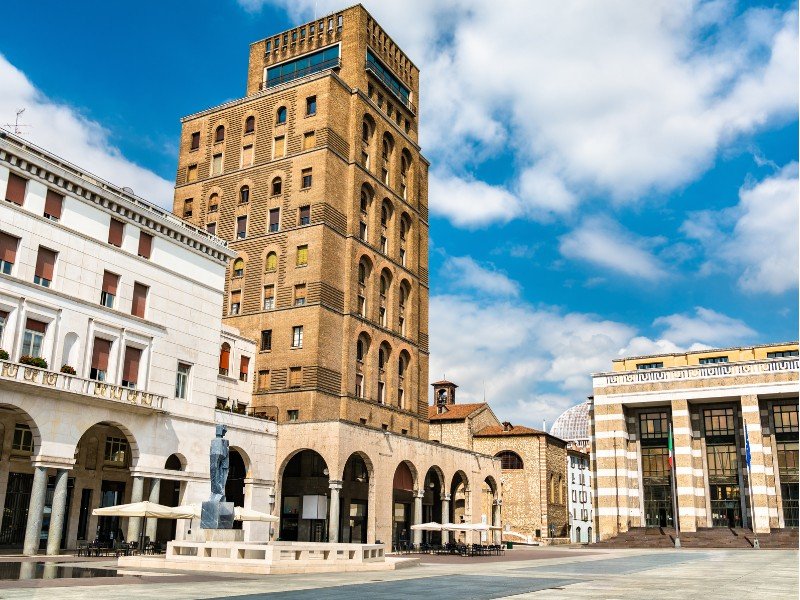
A Walk Through Time
The Echoes of Antiquity
Strolling through Brescia is like walking through an open-air museum, where every cobblestone and corner tells a story. The Roman Capitolium, a UNESCO World Heritage site, stands as a testament to Brescia’s ancient grandeur, while the medieval castle of Brescia, perched high above the city, offers panoramic views and tales of yore. Each epoch, from the Lombards to the Renaissance, has left an indelible mark on the city, creating a mosaic of historical periods.
Culinary Delights
A Taste of Lombardy
Brescia’s culinary scene is as diverse as its history, with traditional Lombard dishes taking center stage. Here, food is a celebration of local produce, from the hearty “casoncelli” (stuffed pasta) to the robust flavors of “spiedo Bresciano” (spit-roasted meats). The city’s vineyards contribute to Italy’s wine legacy, offering exquisite tastings of Franciacorta, a sparkling wine rivaling Champagne.
Cultural Vibrancy
Art and Soul
Beyond its historical sites, Brescia thrives with cultural vibrancy, hosting annual music festivals, art exhibitions, and theater performances that draw locals and visitors alike. The Museo di Santa Giulia, a treasure trove of art and artifacts, narrates the city’s story from prehistory through the Renaissance. Brescia’s modern side is just as compelling, with contemporary art galleries and live music venues dotting the cityscape.
Brescia Today
As the sun sets over the rolling hills that cradle Brescia, the city comes alive with an energy that’s both ancient and youthful. Piazzas fill with families and friends gathering for the evening’s “passeggiata,” a testament to the enduring Italian tradition of community and conviviality. Brescia, with its understated charm and depth of character, invites travelers to discover the Italy that exists beyond postcards and guidebooks—an Italy that’s vibrant, authentic, and infinitely fascinating.
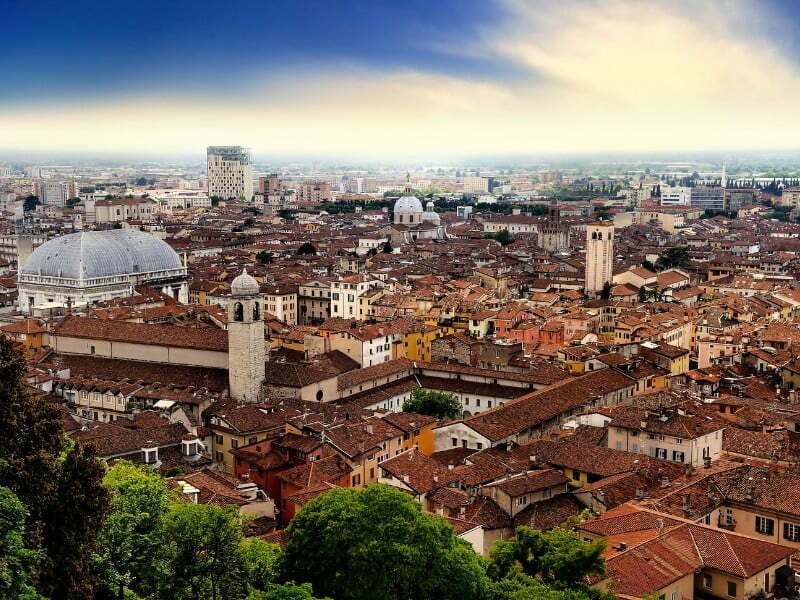
Brescia City Guide: A Brief History Of Brescia, Italy
Unlike the bustling tourist hubs of Italy, Brescia offers a quieter, more introspective journey into the past, where history doesn’t just whisper; it speaks volumes. From its ancient Roman roots to its pivotal role in the Italian unification, Brescia’s history is a fascinating tapestry of resilience, innovation, and artistry.
The Dawn of Brixia
An Ancient Crossroad
The story of Brescia, or Brixia as it was known in ancient times, begins long before the Romans, with settlements dating back to the Bronze Age. Yet, it was the Romans who left a lasting imprint, transforming it into a bustling city. The Roman Capitolium, the forum, and the ancient theatre are but remnants of a grand past, offering a glimpse into life in ancient Brixia.
Medieval Might
The Lombard Legacy
As the Roman Empire waned, Brescia found new life under the Lombards, a warrior people who saw the strategic and cultural value of the city. The Lombard rule infused Brescia with a unique character, exemplified by the Monastic Complex of San Salvatore-Santa Giulia, a UNESCO World Heritage site. This era left a mark on Brescia’s architectural and cultural landscape, embedding the city firmly in the annals of medieval history.
The Renaissance Rebirth
A Flourishing of Arts
The Renaissance swept through Brescia, bringing with it a wave of artistic and architectural innovation. The city became a canvas for artists and architects who adorned it with elegant palaces, public buildings, and stunning frescoes. It was a time of intellectual fervor and artistic expression, with Brescia contributing its voice to the chorus of the Italian Renaissance.
The Lioness of Italy
A Spirit Unbowed
Brescia’s most defining moment came in the 19th century during the Ten Days of Brescia in 1849 when the city rose in revolt against Austrian rule. This act of defiance earned Brescia the title “The Lioness of Italy,” bestowed by none other than Garibaldi. The spirit of independence and resilience shown during this period remains a source of pride and identity for Brescians.
Modern Metamorphosis
An Industrial Powerhouse
Emerging into the 20th and 21st centuries, Brescia embraced industrialization, becoming a leader in the metallurgical and mechanical sectors. Yet, despite its modern advancements, the city has preserved its historical heritage, blending the old with the new in a seamless tapestry.

Brescia Top Attractions and Best Places to Visit in Italy
Brescia doesn’t come up in tourist guides much, as it is an industrial city in Italy. But, its abundance of museums, Roman ruins, and castles make it a hidden gem. If you’re looking to leave the foreign crowds behind, give this place a look.
Begin your time in Brescia by visiting Tempio Capitolino e Piazza del Foro. Back in 73 AD, this ruins complex was a temple dedicated to Roman gods Minerva, Juno, and Jupiter. What’s more, there are also remnants of an earlier temple erected during the reign of Julius Caesar.
While only fragments of this landmark remain, you’ll still find sculptures, frescoes, and mosaics. The entrance fee is 8 EUR. But you can save money by buying the Brescia Card, which covers admission to this attraction and many others in town.
After that, spend a couple of hours inside Museo di Santa Giulia. This institution calls a former monastery its home. Its frescoes and murals are a major draw, as curators have preserved them as they were centuries ago.
More Attractions
But this museum isn’t just about this monastery’s past. It also contains artifacts from the past of Brescia. These include items from Roman times and religious implements like crosses and artworks. Admission is 10 EUR, but again, you can get a better deal by getting a Brescia Card.
Art lovers will also want to include Pinacoteca Tosio Martinengo in their Brescia travel itinerary. It’s a great sport for those tired of the “masters”, as this 170-year-old gallery mostly showcases local artists. However, you’ll find a few top-tier creatives, like Raphael, on its walls.
Throughout its 21 exhibits, you’ll find over 800 works of art. And unlike other attractions in this town, admission is free.
If you like churches, ensure you make room for Duomo Vecchio di Brescia in your schedule. Dating to the 11th century, this ancient church is one of the best examples of Romanesque architecture in Italy. Within, its paintings, frescoes, main altar, and the sarcophagus of Bishop Berardo Maggi are the main highlights.
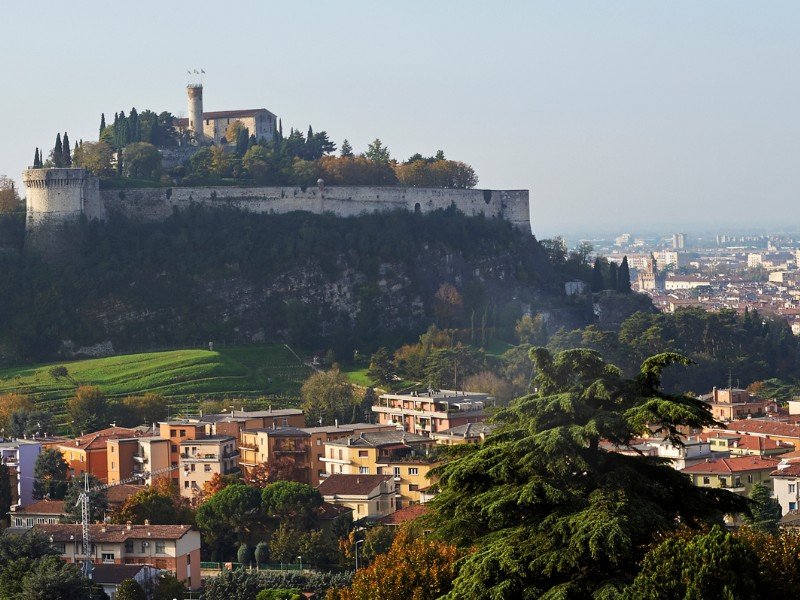
Other Cultural Attractions: Trip to Brescia, Italy
If you have more time in Brescia, expand your itinerary by including Brescia Castle in it. It sits atop Cidneo Hill, which stands more than 240 metres above the city below. This advantageous position has been home to fortifications since Roman times. However, the current structure dates from the medieval era.
The castle grounds are impressive on their own, as its owners have done a great job maintaining its ramparts and walls. Along its perimeter, you’ll find many cannons as well. But for the full experience, visit the on-site museum, which contains weaponry that once armed this castle’s soldiers.
As a city that’s multiple millennia-old, Brescia has undergone many rebuilds. By visiting the Brescia Underground, you can explore this place’s many layers. From Roman foundations to medieval canals, you’ll find plenty of surprises beneath the streets of Brescia.
Other Attractions
Note that you cannot explore on your own here. To discover the Bresica Underground, you’ll need accompaniment by guides. Through their headlamps and expert commentary, you’ll have a safe and fun time.
If you have an auto racing enthusiast in your group, a trip to Museo Mille Miglia may be in order. This institution’s creators founded it to commemorate the Mille Miglia, an annual motorsports race that ran from 1927 to 1957 in Italy.
Within its galleries, you’ll find replicas of the speed machines from those eras. In particular, check out the old Ferraris and Aston Martins. They may not resemble today’s slick sports cars, but they were curvy enough for their era.
Want to exercise and take in the views around Brescia? Rent a bike and ride it along the Ciclo Pedonabile Vello Toline. Along this four-kilometre trail, you’ll trace the shores of Lake Iseo, passing through several tunnels along the way. Don’t miss it!
source: Expoza Travel on YouTube
Top 20 Things To Do in Brescia, Italy For Visitors
Here are the top 20 things to do in Brescia, ensuring a memorable journey through this lesser-known Italian gem.
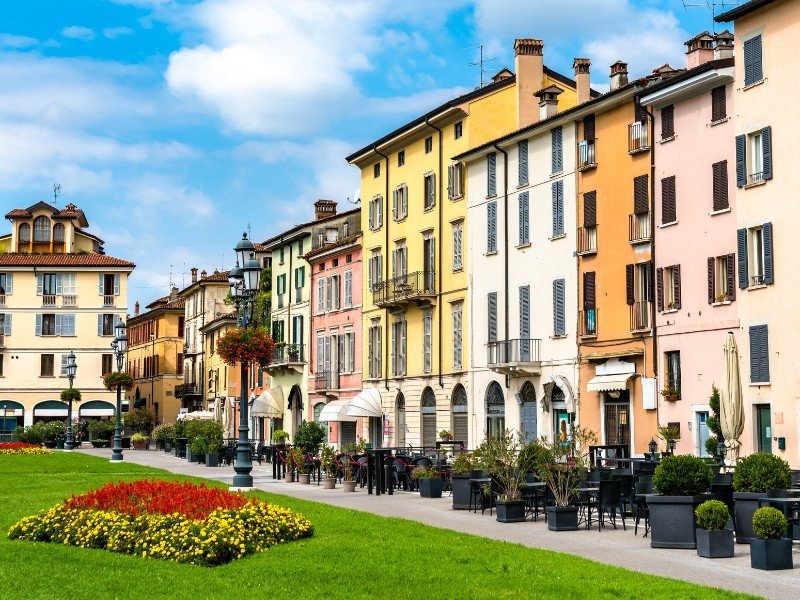
1. Visit the Roman Forum and Capitolium
The Roman Forum and Capitolium are incredible remnants of Brescia’s Roman past. These UNESCO World Heritage sites include the well-preserved ruins of temples and a Roman theater, offering an insightful peek into ancient civilization. Visitors can explore intricate mosaics and artifacts, providing a vivid picture of Roman life. Guided tours enhance the experience with historical context and architectural details.
- Discover ancient ruins of Roman temples and theaters.
- Explore UNESCO-listed archaeological sites with rich history.
- Join a guided tour for in-depth insights into Brescia’s Roman heritage.
2. Explore the Castle of Brescia
The Castle of Brescia is an imposing fortress perched on a hill, offering breathtaking panoramic views of the city. This vast medieval structure houses the Arms Museum and Risorgimento Museum, showcasing Brescia’s historical significance. Walking through the ancient walls and lush gardens transports visitors back in time. The castle’s towers and drawbridges evoke a deep sense of history and grandeur.
- Visit two museums housed within the castle walls.
- Admire panoramic views from the castle’s elevated position.
- Explore medieval towers and gardens, immersing yourself in history.
3. Admire the Old Cathedral (Duomo Vecchio)
The Old Cathedral, also called La Rotonda, is a stunning example of Romanesque architecture with its unique circular structure. Inside, the frescoes and crypt offer a peaceful place for contemplation. The cathedral’s rustic stone exterior contrasts beautifully with the elegant interior. It’s located near the New Cathedral, making it a perfect stop for architecture enthusiasts.
- Admire Romanesque architecture and the circular design of La Rotonda.
- Explore the interior, featuring frescoes and a historical crypt.
- Experience a serene atmosphere, perfect for quiet reflection.
4. Discover the New Cathedral (Duomo Nuovo)
The New Cathedral stands as a magnificent testament to Baroque and Neoclassical design, towering above Brescia. Its construction took over two centuries, resulting in a stunning blend of architectural styles. Inside, the vast spaces are adorned with remarkable artworks, including a famous altarpiece by Titian. Climbing up to the dome rewards visitors with breathtaking views of the city.
- Marvel at Baroque and Neoclassical architecture.
- See the impressive altarpiece by Titian.
- Climb to the dome for panoramic city views.
5. Wander Through Piazza della Loggia
Piazza della Loggia is one of Brescia’s most picturesque squares, featuring Renaissance architecture and charming cafes. The Venetian-style Loggia Palace dominates the square, serving as the city hall. The square’s astronomical clock and Mannerist façades of the surrounding buildings add to its beauty. It’s a lively spot, perfect for people-watching and enjoying local culture.
- Explore Renaissance architecture and historical landmarks.
- Admire the astronomical clock and Mannerist façades.
- Relax at a café and soak in the vibrant atmosphere.
6. Visit the Santa Giulia Museum
The Santa Giulia Museum, housed in a former monastery, is a UNESCO World Heritage site that showcases Brescia’s rich history from ancient times to the present. Visitors can explore Roman artifacts, medieval frescoes, and Renaissance art across the expansive museum complex. The building itself is an architectural gem, featuring Roman ruins and Lombard basilicas. It’s a must-visit for anyone interested in Brescia’s cultural and historical layers.
- Discover Roman, medieval, and Renaissance artifacts.
- Wander through a UNESCO World Heritage site, rich in history.
- Admire the museum’s architectural beauty, including Roman ruins.
7. Enjoy the Natural Beauty of Lake Garda
Just a short drive from Brescia, Lake Garda is Italy’s largest lake, surrounded by stunning scenery and picturesque towns. It’s an ideal destination for sailing, windsurfing, and hiking, with endless recreational opportunities. The towns of Sirmione and Desenzano del Garda add charm, offering thermal springs and historic sites. Lake Garda is perfect for a scenic day trip from Brescia.
- Sail or windsurf on Italy’s largest lake.
- Explore picturesque towns, each with unique attractions.
- Relax in thermal springs and enjoy the lake’s natural beauty.
8. Take a Stroll Along Via dei Musei
Walking down Via dei Musei is like taking a journey through Brescia’s historical timeline. This ancient Roman road links many of the city’s key archaeological and cultural sites, including the Roman Forum and the Santa Giulia Museum. The street itself is an open-air museum, where Roman ruins, public buildings, and basilicas reveal the city’s rich past. It’s a must for history lovers.
- Explore an ancient Roman road, lined with historical landmarks.
- Discover key sites, including the Roman Forum and Santa Giulia Museum.
- Immerse yourself in Brescia’s rich history, all in one stroll.
9. Attend the Mille Miglia
The Mille Miglia is an iconic vintage car race that begins and ends in Brescia, attracting car enthusiasts from around the globe. This annual event features classic automobiles racing through scenic Italian towns and countryside. During the race, Brescia comes alive with exhibitions, parades, and events, celebrating Italy’s love for cars and speed. It’s a fantastic event for both racing fans and casual visitors.
- Watch vintage cars race through stunning Italian landscapes.
- Attend exhibitions and parades, celebrating automotive history.
- Experience the excitement of Italy’s passion for classic cars.
10. Relax in the Parco delle Colline di Brescia
The Parco delle Colline di Brescia is a sprawling natural park, offering a peaceful escape with hiking trails and scenic views. Visitors can explore vineyards, olive groves, and wooded areas that showcase the region’s natural beauty. The park is perfect for hiking, mountain biking, or simply enjoying a relaxing picnic. It’s a refreshing retreat from city life.
- Hike through vineyards and olive groves in this expansive park.
- Enjoy panoramic views of the surrounding landscape.
- Relax with a picnic, surrounded by Lombardy’s natural beauty.
11. Taste Franciacorta Wine
The Franciacorta region, just south of Brescia, is world-renowned for its exquisite sparkling wines, produced using the traditional method. Visiting the local vineyards and wineries provides insight into the intricate wine-making process, with tastings often available. The rolling hills and scenic vineyards add to the experience, making it a perfect destination for wine lovers. Enjoy a taste of Italy’s finest sparkling wine, paired with local food specialties.
- Visit local vineyards for tastings and tours.
- Learn about Franciacorta’s wine-making process.
- Enjoy picturesque views of the region’s rolling hills.
12. Explore the Museo Diocesano di Brescia
The Museo Diocesano di Brescia is a treasure trove of religious art and artifacts, housed in a historic palace. The museum’s collection spans from the early Christian period to modern times, showcasing paintings, sculptures, and liturgical objects. Visitors can explore intricate artworks that reflect Brescia’s religious and artistic traditions. It’s a serene, enriching experience for those interested in spiritual and historical art.
- View religious art from various periods in Brescia’s history.
- Admire liturgical artifacts and sculptures in a historic setting.
- Explore a peaceful museum, reflecting Brescia’s spiritual heritage.
13. Attend a Performance at the Teatro Grande
The Teatro Grande is Brescia’s premier venue for opera, ballet, and theater, with performances dating back to the 17th century. The theater’s lavish interior, complete with frescoes and velvet seats, offers a stunning backdrop for its shows. The program includes a diverse range of performances, from classic to contemporary. Attending a performance here is an unforgettable way to experience Brescia’s rich cultural life.
- Watch world-class performances in opera, ballet, and theater.
- Admire the ornate architecture of this historic theater.
- Enjoy a diverse program, offering something for all tastes.
14. Marvel at the Broletto
The Broletto, with its distinct mix of Romanesque and Gothic architecture, is one of Brescia’s most iconic buildings. Once the seat of medieval government, today it hosts cultural events and exhibitions. The building’s towers and intricate façades reflect Brescia’s evolving architectural styles. Its central location makes it easy to explore nearby historical sites, making it a key stop for visitors.
- Explore a mix of architectural styles, from Romanesque to Gothic.
- Attend exhibitions or cultural events held within its walls.
- Visit nearby historical landmarks, all within walking distance.
15. Visit the Pinacoteca Tosio Martinengo
The Pinacoteca Tosio Martinengo is a must-visit for art enthusiasts, housing an impressive collection of Italian Renaissance paintings. The museum showcases works by Raphael, Titian, and Moretto da Brescia, highlighting the region’s artistic heritage. Recently renovated, the gallery offers a fresh perspective on classic masterpieces. It’s an enriching experience for those looking to immerse themselves in Italian art and culture.
- Admire works by Raphael and Titian, among other masters.
- Explore Renaissance art in a beautifully renovated space.
- Learn about the region’s artistic history, particularly from the Lombardy area.
16. Participate in the Brescia Jazz Festival
The Brescia Jazz Festival is an annual celebration of jazz music, attracting international and Italian musicians alike. Concerts take place in various venues, from historic theaters to outdoor spaces, providing a diverse listening experience. The festival highlights the creativity and improvisation that define jazz, making it a lively and inspiring event. It’s a must for music lovers and those looking to experience Brescia’s vibrant cultural scene.
- Attend concerts in diverse venues, from theaters to outdoor stages.
- Experience live jazz from international and Italian artists.
- Enjoy the festival’s lively atmosphere, celebrating jazz’s creativity.
17. Hike in the Val Trompia
Val Trompia, north of Brescia, is a beautiful valley offering hiking trails, mountain views, and historical sites. Visitors can explore alpine lakes, peaks, and lush forests, making it a perfect destination for nature lovers. The area also has a rich history of iron mining, with museums and workshops available for visitors. It’s a unique blend of natural beauty and industrial heritage, providing an enriching outdoor experience.
- Hike scenic trails through mountains and forests.
- Visit museums and workshops, learning about Val Trompia’s mining history.
- Discover stunning alpine lakes and picturesque landscapes.
18. Sample Local Cuisine
Brescia offers a rich culinary experience, with local specialties like casoncelli (stuffed pasta), polenta, and risotto featuring prominently on menus. The city’s restaurants range from traditional trattorias to modern eateries, offering something for every palate. Dining in Brescia is a delightful way to experience Lombardy’s culinary heritage. Don’t miss the chance to sample local wines and cheeses, which complement the regional dishes perfectly.
- Try traditional dishes, such as casoncelli and polenta.
- Experience Lombardy’s culinary diversity, from rustic to refined.
- Pair local wines and cheeses with your meal for a full experience.
19. Discover the Museo Mille Miglia
The Museo Mille Miglia is dedicated to the legendary vintage car race that starts and ends in Brescia. The museum showcases classic automobiles, race memorabilia, and interactive exhibits. It tells the story of the Mille Miglia’s impact on automotive history and Italian culture. A visit to this museum is a must for car enthusiasts, offering a deeper understanding of Italy’s passion for speed and design.
- See classic cars from the Mille Miglia race.
- Explore interactive exhibits on automotive design and history.
- Learn about Italy’s rich automotive culture, through this iconic race.
20. Visit the Church of San Salvatore-Santa Giulia
The Church of San Salvatore-Santa Giulia is part of the Santa Giulia Museum complex, showcasing beautiful Lombard architecture. Inside, visitors can admire frescoes, stuccoes, and architectural details that span various historical periods. The crypt houses ancient relics and artworks, offering a glimpse into Brescia’s spiritual and artistic history. It’s a serene and enriching stop for those interested in religious art and history.
- Admire Lombard architecture and historical frescoes.
- Visit the crypt, home to ancient relics and artworks.
- Explore Brescia’s spiritual and artistic legacy in a peaceful setting.

What To Eat and Drink in Brescia, Italy
At lunch, find a restaurant that serves Minestra Sporca. Don’t let this soup’s name turn you off (it literally means “dirty soup” in Italian). It refers to the disparate ingredients, not its cleanliness. In this dish, you’ll find liver, rice, onions, carrots, and potatoes in a chicken broth. Served with cheese over top, it is a hearty meal.
For dinner, have some Uccelli Scappati. Once again, this dish’s Italian name can cause confusion. Translated literally to “escaped birds”, it is what hunters would eat when they failed to bring home freshly killed fowl.
This meal uses veal or pork as its source of protein. Cooks take this meat, roll it in pancetta, put it on skewers, put sage on it, then cook it with butter and white wine. Not a bad consolation dish!
End your day with a slice of Pandoro. Pandoro is a sweet bread made with loads of sugar and egg yolk and is topped with whipped cream or melted chocolate. Usually, this bread is only found around Christmas, so don’t miss your chance to have it.
Brescia, nestled in the Lombardy region, is a haven for food enthusiasts, offering a rich tapestry of flavors that reflect its historical layers and geographical bounty. From hearty traditional dishes to exquisite wines, Brescia’s culinary scene is as diverse as its heritage. Here’s a comprehensive guide to the must-try foods and drinks when in Brescia, each promising to provide a taste of the region’s soul.
Traditional Dishes
1. Casoncelli alla Bresciana
- A staple of Brescian cuisine, these are ravioli-like pasta filled with breadcrumbs, Parmesan, eggs, and various meats. Served with melted butter, sage, and more grated Parmesan, they’re a testament to the region’s love for rich, comforting flavors.
2. Manzo all’olio di Rovato
- This slow-cooked beef dish is a true representation of Brescia’s culinary tradition. Cooked gently in olive oil and flavored with anchovies and garlic, it’s typically accompanied by polenta, embodying the heartiness of Lombard cuisine.
3. Spiedo Bresciano
- A feast for meat lovers, this dish involves various meats (often including birds like quails) slowly roasted on a spit, basted with butter, and served with savory polenta. It’s a communal dish, reflecting the warmth and generosity of Brescia’s dining culture.
Bakery Treats
4. Spongada
- These soft, sweet breads, often prepared for Easter, are filled with a mix of eggs, butter, sugar, and lemon zest, showcasing the region’s love for festive, flavorful baked goods.
5. Rustici
- A testament to Brescia’s bakery prowess, Rustici are flaky pastries filled with spinach, ricotta, or other savory fillings, perfect for a quick snack while exploring the city.
Cheeses and Salumi
6. Bagòss
- Hailing from the Bagolino town in the Brescia province, this hard, grainy cheese made from cow’s milk is aged to perfection, offering nutty flavors that pair beautifully with local wines.
7. Salame di Varzi
- A delicious example of Brescia’s charcuterie, this salami, seasoned with wine and garlic, is often enjoyed as part of an antipasto, showcasing the region’s mastery in preserving meats.
Sweet Delights
8. Torta Bertolina
- A harvest cake that dates back centuries, made with cornmeal, apples, and raisins, reflecting the agricultural roots of Brescia’s cuisine. It’s a taste of history in every bite.
Beverages
9. Franciacorta
- No culinary journey through Brescia is complete without savoring Franciacorta, the sparkling wine produced in the region. Rivaling the best champagnes, it’s a celebration of Lombardy’s viticulture.
10. Pirlo
- Brescia’s answer to the Spritz, this aperitif combines white wine, Campari or Aperol, and sparkling water, serving as the perfect prelude to any meal.
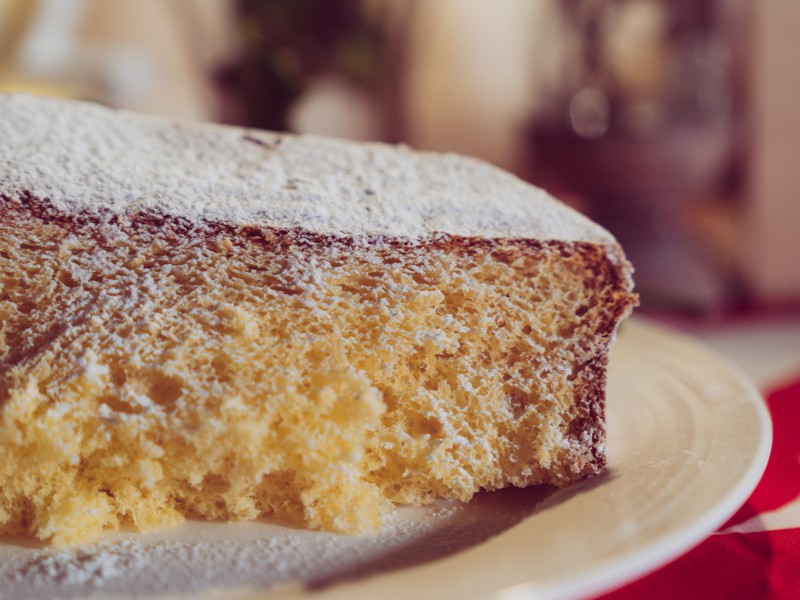
Top Restaurants In Brescia, Italy
From historic trattorias nestled in ancient piazzas to modern eateries pushing the boundaries of Italian cooking, here’s a list of top restaurants in Brescia where the essence of Italian dining comes to life.
1. Trattoria Al Bianchi
- Nestled in the heart of Brescia, Trattoria Al Bianchi is a historic eatery renowned for its traditional Brescian dishes. With a cozy atmosphere that feels like a step back in time, it offers specialties like “Casoncelli alla Bresciana” and “Spiedo Bresciano,” made with locally sourced ingredients.
2. La Vineria
- La Vineria is both a restaurant and a wine bar, boasting an extensive selection of regional wines paired with inventive dishes that highlight the flavors of Lombardy. Its chic, modern interior provides a sophisticated backdrop for a memorable dining experience.
3. Osteria della Villetta
- A gem located in the outskirts of Brescia, Osteria della Villetta offers a menu rooted in tradition, served in a charming setting reminiscent of a bygone era. The restaurant is celebrated for its handcrafted pasta, succulent meats, and warm, welcoming service.
4. Dispensa Pani e Vini
- This contemporary restaurant and wine shop in Franciacorta, just a short drive from Brescia, is known for its modern approach to Italian cuisine and an impressive wine list featuring the best of Franciacorta’s sparkling wines. The menu creatively combines local ingredients with international flavors, served in a stylish, relaxed environment.
5. Ristorante I Du dela Contrada
- Situated in the medieval heart of Brescia, this restaurant offers an elegant dining experience with a menu that celebrates seasonal ingredients and traditional recipes with a creative twist. The intimate atmosphere and refined dishes make it perfect for special occasions.
6. Locanda delle Grazie
- Located near the UNESCO World Heritage sites of Brescia, Locanda delle Grazie is famed for its dedication to preserving the culinary heritage of Lombardy. The restaurant serves up hearty, comforting dishes in a rustic setting, with a focus on the rich agricultural bounty of the region.
7. L’Osteria H
- A contemporary twist on the classic osteria, L’Osteria H serves innovative dishes that draw inspiration from Brescian culinary traditions, presented with modern flair. The restaurant’s minimalist decor and attentive service complement its forward-thinking menu.
8. Mille Storie e Sapori
- Known for its vast selection of cheeses and salumi, Mille Storie e Sapori is part deli, part restaurant, offering a casual dining experience that emphasizes the quality and diversity of Italian charcuterie, paired with excellent wines.
9. Trattoria del Glicine
- Set in the picturesque Franciacorta countryside, Trattoria del Glicine is an idyllic spot for enjoying the region’s traditional cuisine. The restaurant is housed in a charming old farmhouse, with a menu that pays homage to the simplicity and richness of Lombard dishes.
10. Dioniso
- Dioniso stands out for its seafood offerings, bringing the flavors of the Italian coast to the heart of Brescia. The restaurant prides itself on its fresh, high-quality ingredients and its elegant presentation, offering a refined take on Mediterranean cuisine.

Tours For Visitors To Brescia, Italy
Here’s a comprehensive guide to the top tours for visitors to Brescia, Italy.
1. Historical Brescia Walking Tour
- Discover the heart of Brescia with a guided walking tour through its historic center. Visit ancient landmarks like the Roman Capitolium, the medieval Brescia Castle, and the Renaissance-style Piazza della Loggia. This tour offers insights into the city’s evolution from an ancient Roman settlement to a vibrant modern city.
2. The UNESCO Sites: Brescia’s Longobards Legacy
- Explore the UNESCO World Heritage sites of San Salvatore-Santa Giulia and the Monastic Complex, showcasing the Longobards’ profound influence on Brescia. This tour not only highlights architectural marvels but also delves into the cultural and historical significance of the Longobard era in shaping Brescia and Europe.
3. Franciacorta Wine Tour
- Venture into the rolling hills of the Franciacorta region, just a short drive from Brescia, for a wine tour that indulges the senses. Visit renowned wineries, learn about the traditional method of producing Franciacorta sparkling wine, and enjoy tastings that highlight the area’s viticultural excellence.
4. Brescia’s Gastronomic Tour
- Embark on a culinary journey through Brescia’s bustling markets, historic bakeries, and traditional eateries. Sample local specialties like casoncelli alla Bresciana and manzo all’olio di Rovato, and learn about the ingredients and traditions that make Lombard cuisine unique.
5. Brescia by Bike: City and Countryside
- Experience Brescia and its picturesque surroundings on a guided bike tour. Cycle through the city’s charming streets and venture into the countryside, exploring vineyards, ancient villages, and serene landscapes. This tour combines physical activity with cultural immersion, offering a different perspective on the region.
6. Art and Museums of Brescia
- Dive into Brescia’s rich artistic heritage with a tour of its museums and galleries. Highlights include the Museo di Santa Giulia, with its vast collection spanning from prehistory to the modern age, and the Pinacoteca Tosio Martinengo, home to Renaissance masterpieces.
7. Industrial Brescia: From Iron to Innovation
- Discover Brescia’s industrial roots and its role as a modern manufacturing hub with a tour focusing on its metallurgical history and contemporary innovation. Visit historic sites and modern factories to understand how Brescia became known as the “Lioness of Italy” for its economic strength.
8. Brescia’s Hidden Gems: Off the Beaten Path
- For those looking to explore beyond the well-trodden paths, this tour reveals Brescia’s hidden gems. Discover secret gardens, tucked-away art installations, and lesser-known historical sites that offer a glimpse into the city’s quirky and mysterious side.
9. Lake Garda Day Trip
- Just a stone’s throw from Brescia, Lake Garda offers breathtaking natural beauty, charming lakeside towns, and a plethora of recreational activities. Enjoy a day trip to Italy’s largest lake, exploring its scenic shores, medieval castles, and vibrant markets.
10. Brescia at Night: Ghosts and Legends Tour
- Experience a different side of Brescia with a nighttime tour exploring local legends and ghost stories. Wander through ancient streets and dark alleyways as you hear tales of the city’s mysterious past, bringing a touch of intrigue to your visit.
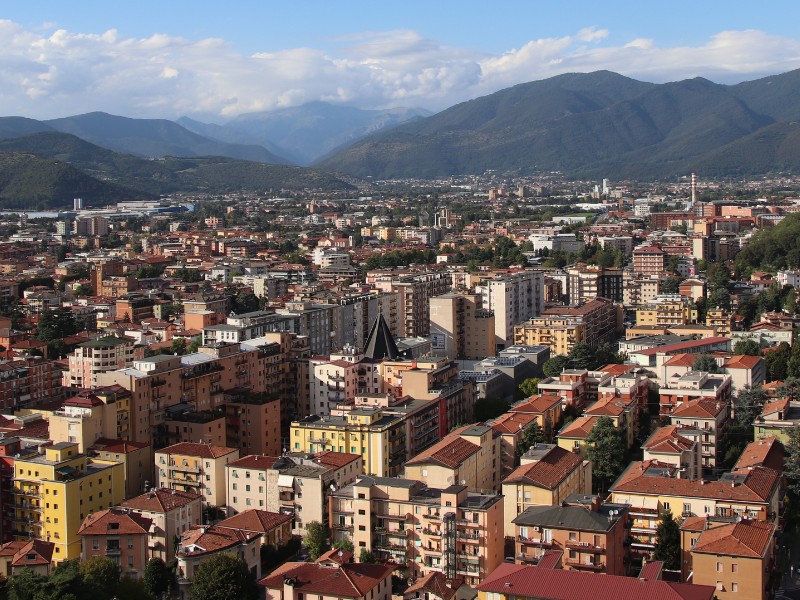
Brescia Accommodations Guide: Hotels, Guesthouses and Hostels
Here’s a travel guide to some of the top places to stay in Brescia, each providing a unique gateway to experiencing this vibrant city.
Luxury and Boutique Hotels
1. Hotel Vittoria
- The Hotel Vittoria stands as a testament to Brescia’s elegance, offering a luxurious stay in a prime location near the city’s main attractions. This 5-star hotel, situated near Piazza della Loggia and the Roman ruins, boasts Art Deco interiors and provides exemplary service, making it a favorite among discerning travelers.
2. L’Albereta Relais & Chateaux
- A short drive from Brescia, nestled in the rolling hills of Franciacorta, L’Albereta offers a luxurious retreat in a picturesque setting. This boutique hotel is known for its spa, fine dining, and exquisite rooms, some with unique features like retractable roofs to enjoy the starlit sky.
Mid-Range Options
3. Hotel Ambasciatori
- Offering comfort and convenience, the Hotel Ambasciatori provides excellent value with modern amenities, spacious rooms, and attentive service. Its location makes it a great base for exploring Brescia and the surrounding Lombardy region.
4. Regal Hotel and Apartments
- Ideal for travelers looking for flexibility, the Regal Hotel and Apartments offers both traditional hotel rooms and apartment-style accommodations. With its friendly atmosphere and additional facilities like a swimming pool and a restaurant, it’s perfect for families and longer stays.
Budget-Friendly Hostels and Guesthouses
5. Ostello Locanda degli Acrobati
- A favorite among budget travelers and backpackers, this hostel offers a charming and friendly place to stay in the heart of Brescia. With dormitory and private room options, it’s a great choice for those looking to meet fellow travelers.
6. Casa Marcolini Bevilacqua
- This guesthouse provides a homey and comfortable stay in a historic setting. Offering both private rooms and shared accommodations, it’s an excellent option for travelers seeking an authentic experience without breaking the bank.
Unique Stays
7. Al Castello
- Situated in the shadow of Brescia’s castle, this boutique guesthouse offers a unique stay with stunning views of the city and the surrounding countryside. The beautifully restored rooms, combined with personalized service, make for a memorable visit.
8. Agriturismo San Faustino
- For those wishing to experience Brescia’s countryside, Agriturismo San Faustino offers rustic yet comfortable accommodations amidst vineyards and olive groves. It’s an ideal choice for wine enthusiasts and nature lovers.
For the Modern Traveler
9. AC Hotel Brescia by Marriott
- With its sleek design and contemporary amenities, the AC Hotel Brescia appeals to business and leisure travelers alike. Located near the train station and Brescia’s business district, it provides convenience and style.
10. Hotel Igea
- A stone’s throw away from the central station, Hotel Igea is a modern hotel offering clean, comfortable rooms and excellent service. It’s a great base for exploring Brescia and the nearby areas, including Lake Garda and the Franciacorta wine region.
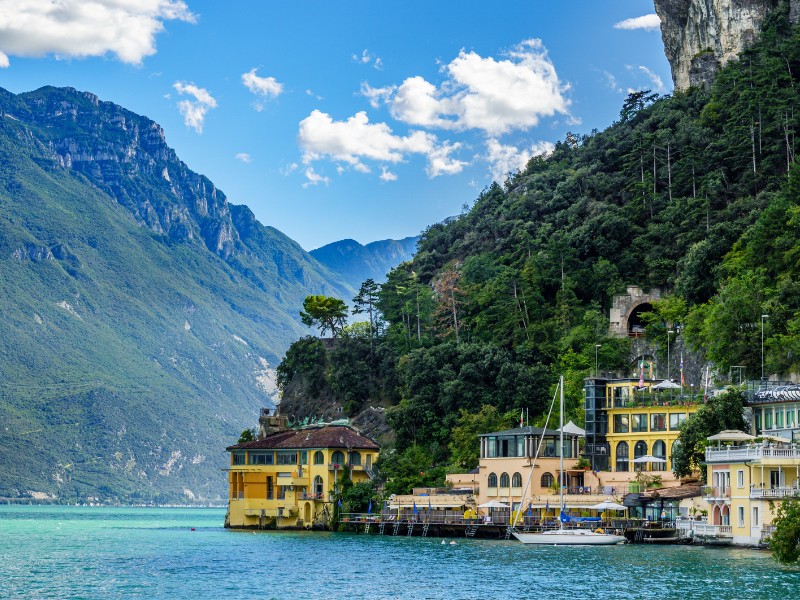
Day Trips From Brescia, Italy
Brescia offers a plethora of day trip options that cater to lovers of nature, history, and gastronomy alike. Here’s a guide to some of the most captivating day trips from Brescia, each promising an unforgettable experience.
1. Lake Garda
- Just a short drive from Brescia, Lake Garda is Italy’s largest lake, offering breathtaking natural beauty, charming towns, and a range of outdoor activities. Visit Sirmione to explore its Roman villa and medieval castle, enjoy water sports in Riva del Garda, or take a leisurely boat tour around the lake. The lakeside towns, each with their unique character, are perfect for enjoying local cuisine and gelato. Lake Garda’s blend of natural beauty, historical sites, and vibrant town life makes it an ideal day trip.
2. Franciacorta Wine Region
- Renowned for its exquisite sparkling wines, the Franciacorta region offers guided tours and tastings at various wineries set amidst rolling hills and picturesque vineyards. Learn about the traditional method of sparkling wine production that rivals Champagne. The region also boasts historical sites, including the Abbey of San Pietro in Lamosa. A day in Franciacorta combines the pleasures of wine tasting with the beauty of Lombardy’s countryside.
3. Verona
- Famous as the setting of Shakespeare’s “Romeo and Juliet,” Verona is a UNESCO World Heritage site with well-preserved Roman, medieval, and Renaissance architecture. Explore the ancient Arena, stroll through Piazza delle Erbe, and visit Juliet’s house. Verona’s vibrant cultural scene, historic sites, and romantic atmosphere make it a must-visit. The city is just an hour’s drive from Brescia, offering a perfect blend of history, art, and romance.
4. Bergamo
- Split into the Città Alta (Upper Town) and Città Bassa (Lower Town), Bergamo is known for its Venetian walls, cobblestone streets, and rich history. Take the funicular to the Città Alta for stunning views, visit the Basilica di Santa Maria Maggiore, and enjoy Bergamo’s culinary delights. Bergamo’s blend of picturesque landscapes and historical intrigue provides a fascinating escape from Brescia. The city’s charm lies in its ability to merge its historical heritage with a vibrant modern life.
5. Cremona
- Celebrated for its violin-making tradition, Cremona is home to the Violin Museum and numerous artisan workshops where you can learn about the craft of stringed instruments. The city’s Torrazzo, the tallest pre-modern tower in Italy, offers panoramic views. Cremona’s rich musical history, coupled with its beautiful architecture and delicious torrone (nougat), makes it an intriguing day trip destination. It’s a city that appeals to both the senses and the intellect.
6. Mantua (Mantova)
- Surrounded by three artificial lakes, Mantua is a Renaissance gem known for the Palazzo Ducale, the sprawling residence of the Gonzaga family, and the frescoes by Mantegna in the Camera degli Sposi. The city’s historical significance as a hub of Renaissance art and culture earned it a UNESCO World Heritage designation. Mantua is also famed for its culinary tradition, including dishes like pumpkin ravioli. A visit to Mantua offers a deep dive into Northern Italy’s artistic and culinary heritage.
7. Parma
- Known for its Parmigiano Reggiano cheese and Parma ham, this gastronomic paradise also boasts impressive cultural sites, including the Parma Cathedral and the Teatro Regio, famous for its opera performances. Parma’s culinary tours offer a taste of the region’s finest products. The city’s blend of art, music, and gastronomy provides a rich sensory experience. Parma exemplifies the deep connection between Italian culture and its culinary traditions.
8. Milan
- As Italy’s fashion and design capital, Milan offers an array of attractions from the iconic Duomo and Leonardo da Vinci’s Last Supper to the bustling Galleria Vittorio Emanuele II and the vibrant Navigli district. Milan’s mix of historical sites and modern cosmopolitan life offers something for every traveler. The city is a hub of creativity, from high fashion to cutting-edge design and art. A day trip to Milan from Brescia offers a glimpse into Italy’s future while still honoring its past.
9. Padua (Padova)
- Padua is renowned for the Scrovegni Chapel, with frescoes by Giotto, and the historic University of Padua, where Galileo once taught. The city’s botanical garden is the world’s oldest, offering a peaceful retreat. Padua’s mix of scholarly tradition and artistic beauty makes it a fascinating destination. The city offers a blend of intellectual history and artistic splendor that is both inspiring and serene.
10. Vicenza
- Known as the city of Palladio, Vicenza is home to many architectural masterpieces by the Renaissance architect Andrea Palladio, including the iconic Basilica Palladiana and the Teatro Olimpico. The city’s elegant architecture has earned it a UNESCO World Heritage status. Vicenza is also a gateway to exploring the Veneto region’s villas and countryside. It offers an architectural journey through Palladio’s influential vision, making it a must-visit for art and architecture enthusiasts.
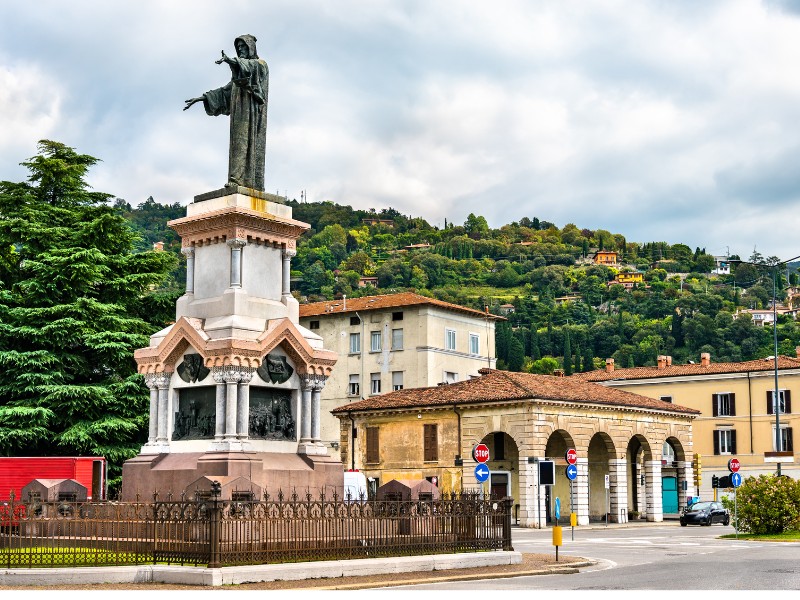
Brescia Transportation Guide
Here’s our travel guide to getting around Brescia and venturing beyond into the picturesque Lombardy region.
Arriving in Brescia
1. By Air
- The nearest major airport is Orio al Serio International Airport (BGY) in Bergamo, approximately 45 minutes away by car or shuttle service. This airport serves many European and international flights, providing easy access to Brescia. Additionally, Milan’s airports (Linate and Malpensa) are also viable options with broader flight selections and are connected to Brescia by train and bus services.
2. By Train
- Brescia is well-served by Italy’s extensive railway network, including high-speed trains (Frecciarossa and Frecciabianca) connecting it to major cities like Milan, Verona, and Venice. The central railway station, Brescia Stazione, is located in the heart of the city, making it a convenient entry point for visitors.
Getting Around Brescia
3. Public Buses
- Brescia’s urban and suburban areas are serviced by a comprehensive network of buses operated by Brescia Mobilità. These buses connect the city center with suburbs, the railway station, and key attractions. Tickets can be purchased at kiosks, tobacco shops, or directly on the bus.
4. Metro
- The Brescia Metro is a quick and efficient way to navigate the city. It runs from Prealpino in the north to Sant’Eufemia-Buffalora in the south, covering major points of interest, including the train station and the city center. The metro operates at frequent intervals, making it a convenient option for both locals and tourists.
5. Bike Sharing
- Brescia encourages eco-friendly transportation with its bike-sharing program, Bicimia. With numerous docking stations spread across the city, it’s an excellent way for visitors to explore at their own pace. The first 45 minutes of each ride are free, making this an affordable and enjoyable transportation option.
Exploring Beyond Brescia
6. Car Rental
- Renting a car provides the flexibility to explore the scenic Lombardy region, including Lake Garda, the Franciacorta wine country, and the Alps. Numerous car rental agencies are available at the airport and in the city. Remember, driving in Italy requires an international driver’s license for visitors from outside the EU.
7. Regional Trains and Buses
- For day trips from Brescia to nearby cities and attractions, regional trains and buses offer convenient and economical options. The Lombardy regional transportation network, Trenord, provides services to destinations like Lake Iseo, Milan, and the picturesque towns of Lombardy.
8. On Foot
- Brescia’s city center is compact and pedestrian-friendly, making walking an excellent way to explore its historical sites, museums, and shopping areas. Many of the city’s attractions are within easy walking distance of each other.
Additional Tips
- Brescia Mobilità Card: For visitors planning to use public transport extensively, the Brescia Mobilità Card offers unlimited travel on buses and the metro, along with discounts at museums and attractions.
- Parking: If you’re driving, be aware of ZTL zones (limited traffic zones) in the city center where access is restricted. Use designated parking areas outside these zones to avoid fines.
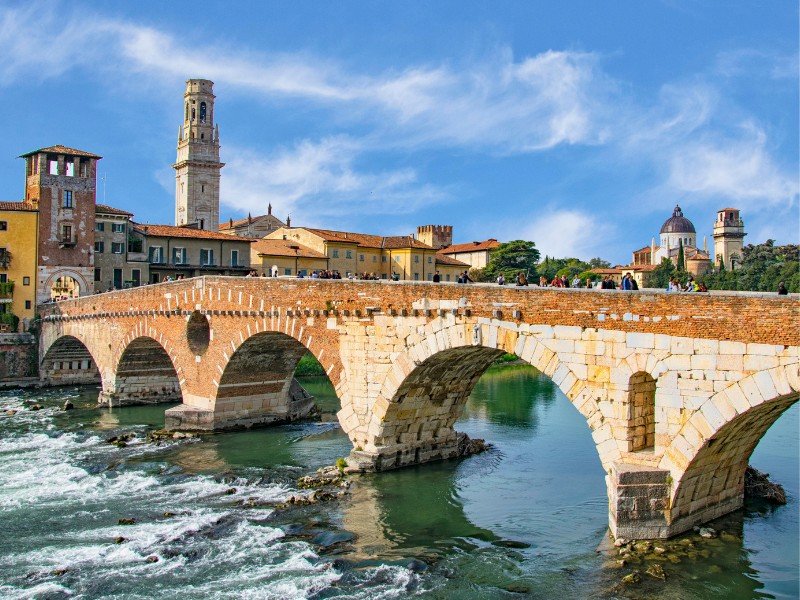
Where To Visit After Your Trip To Brescia?
The region surrounding Brescia is a mosaic of diverse landscapes and experiences. Here’s a guide to captivating destinations to consider visiting after your journey in Brescia, each offering its unique allure.
1. Lake Garda
- Just a stone’s throw from Brescia, Lake Garda is Italy’s largest lake, famed for its crystal-clear waters, charming towns, and scenic beauty. Explore the medieval castles of Sirmione, enjoy water sports in Torbole, or simply relax in the lush gardens of Gardone Riviera. The lake’s microclimate supports a flora that includes lemon trees, oleanders, and cypresses, making it a unique ecological zone. Lake Garda’s combination of natural beauty and historical sites makes it a must-visit for any traveler.
2. Verona
- Known worldwide as the setting of Shakespeare’s “Romeo and Juliet,” Verona offers a rich tapestry of history, art, and culture. From the well-preserved Roman Arena to the romantic balconies of Juliet’s house, the city is a UNESCO World Heritage site for its urban structure and architecture. Verona also hosts a vibrant calendar of events, including one of Italy’s most prestigious opera festivals. Its charming streets, ancient bridges, and vibrant piazzas are perfect for those looking to immerse themselves in Italian culture.
3. Milan
- As Italy’s fashion and financial capital, Milan is a dynamic city that blends modernity with rich history. Marvel at the gothic splendor of the Duomo, view Leonardo da Vinci’s “The Last Supper,” or indulge in world-class shopping in the Galleria Vittorio Emanuele II. Milan’s bustling nightlife and gastronomic scene offer endless entertainment and dining options. It’s a city where the pulse of innovation beats strong, making it an exciting next stop after Brescia.
4. Bergamo
- Divided into the Città Alta (Upper Town) and Città Bassa (Lower Town), Bergamo is renowned for its Venetian walls, cobblestone streets, and rich artistic heritage. The Città Alta, accessible by a funicular, offers breathtaking views, historical sites, and a step back into medieval times. Bergamo’s cuisine, featuring polenta, taleggio cheese, and casoncelli pasta, reflects the rich culinary traditions of Lombardy. It’s a city that combines the charm of a bygone era with the vibrancy of modern life.
5. Lake Iseo
- Smaller and less crowded than its neighboring lakes, Lake Iseo offers tranquility and beauty in spades. Visit the largest lake island in Europe, Monte Isola, and explore its picturesque villages and olive groves by foot or by bike. The lake is also the gateway to the Franciacorta wine region, known for its exquisite sparkling wines. Lake Iseo’s understated charm makes it an ideal destination for those seeking peace and natural beauty.
6. Mantua (Mantova)
- Surrounded on three sides by artificial lakes, Mantua is a Renaissance city with a rich history as the seat of the Gonzaga family. Its artistic heritage includes the Palazzo Ducale, the Basilica of Sant’Andrea, and the frescoes by Mantegna. Mantua is also celebrated for its culinary contributions, including pumpkin-filled tortelli and sbrisolona cake. The city, a UNESCO World Heritage site, offers a blend of architectural marvels and gastronomic delights.
7. Dolomites
- For nature lovers and adventurers, the Dolomites offer breathtaking mountain landscapes, outdoor sports, and serene beauty. Whether you’re hiking in the summer, skiing in the winter, or simply enjoying the panoramic views, the Dolomites provide a dramatic change of scenery from Brescia’s urban landscape. The region is also known for its unique Ladin culture, language, and cuisine. The majestic peaks and valleys of the Dolomites are a playground for the active and a sanctuary for those seeking tranquility.
8. Padua (Padova)
- Padua is a historic university city with a vibrant cultural scene, ancient streets, and beautiful arcades. The Scrovegni Chapel, with Giotto’s frescoes, the historic University of Padua, and the bustling Prato della Valle square are highlights. Padua is also renowned for its botanical garden, the oldest in the world, offering a peaceful retreat. The city’s blend of intellectual heritage and artistic beauty makes it a stimulating destination.
9. Venice
- The enchanting city of Venice, with its intricate network of canals, historic architecture, and artistic heritage, is a world-renowned marvel. Explore the iconic St. Mark’s Square, the Doge’s Palace, and take a gondola ride through the serene canals. Venice’s atmosphere is unique, filled with mystery, romance, and an ever-present sense of history. It’s a city that must be experienced, offering endless discoveries with every visit.
10. Cinque Terre
- Though a bit farther away, the Cinque Terre is worth the journey for its stunning coastal scenery, colorful villages, and hiking trails. The five villages offer a glimpse into traditional Italian coastal life, with terraced vineyards, local seafood, and picturesque harbors. The area is best explored on foot, with trails connecting each village offering spectacular views of the Ligurian Sea. Cinque Terre’s combination of natural beauty and cultural charm encapsulates the essence of Italy’s varied landscapes.
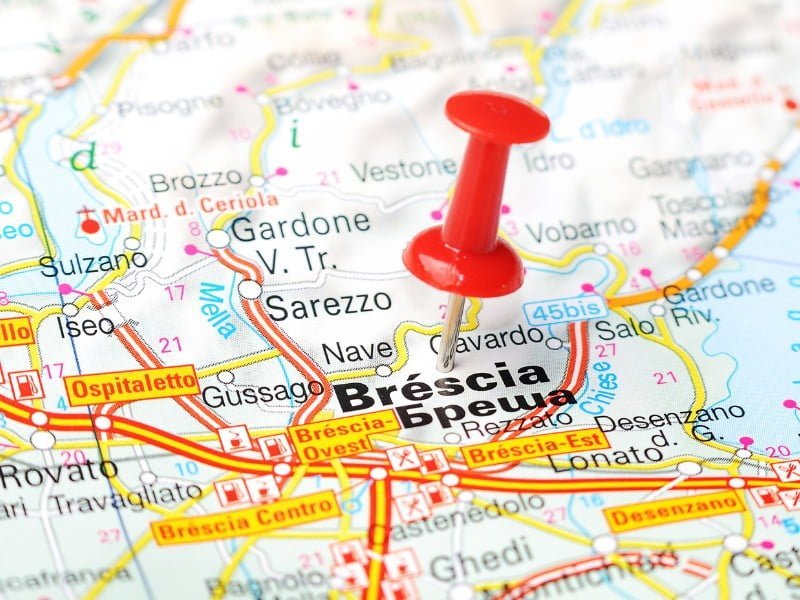
Brescia Travel Guide: Final Thoughts
Brescia is a treasure trove of history, culture, and culinary delights, a place where every alley, square, and stone tells a story. It’s a city that may not command the instant recognition of Venice or Rome but offers a depth and authenticity that is equally compelling. Brescia invites travelers to explore Italy beyond the usual tourist paths, offering an experience that is both enriching and profoundly personal.
The Soul of Lombardy
From the ancient Roman ruins that silently narrate centuries-old tales to the Renaissance elegance that adorns its streets, Brescia embodies the spirit of Lombardy in every aspect. The city, with its storied past and vibrant present, serves as a testament to the enduring allure of Italian culture. It’s a place where art and history are not just preserved but are a living, breathing part of daily life.
A Culinary Journey
Brescia’s culinary landscape is a reflection of its rich heritage, offering flavors that are as varied as they are delicious. From the hearty “casoncelli” to the exquisite Franciacorta sparkling wine, dining in Brescia is an adventure in itself. It’s a journey that not only satisfies the palate but also connects you to the land and its traditions.
Beyond the City Limits
And yet, the allure of Brescia extends beyond its city limits, serving as a gateway to the enchanting landscapes of Lombardy and beyond. Whether it’s the serene beauty of Lake Garda, the verdant hills of Franciacorta, or the historic streets of Verona and Milan, Brescia is the perfect starting point for explorations that are as diverse as they are memorable.
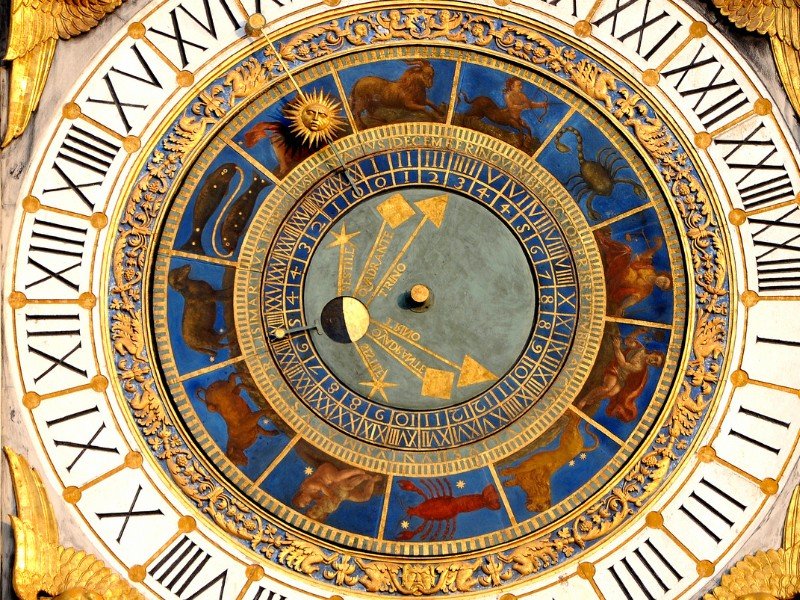
Ode To Brescia
In Brescia’s embrace, a story unfolds, A city of history, where tales are told. From ancient ruins to Renaissance grace, Brescia beckons, a captivating place.
Walk through its streets, where time stands still, Marvel at arches, each detail a thrill. Cobblestones whisper of footsteps past, Echoes of a legacy that forever lasts.
Explore the castle, proud and grand, With ramparts high, it surveys the land. From its towers, a panorama unfolds, Revealing Brescia’s secrets untold.
Santa Giulia Museum, a treasure trove, With art and artifacts, it captures the love Of cultures that thrived in this ancient land, Leaving their mark, a gift from each hand.
Savor the flavors that Brescia bestows, Casoncelli and polenta, culinary echoes. Wines from Franciacorta, sparkling and fine, Toasting to moments, memories divine.
In piazzas, life dances, vibrant and bright, Laughter and music fill the night. Brescia’s warmth, a welcome embrace, Inviting you to be part of its grace.
So wander through history, explore with delight, Brescia’s allure, a traveler’s delight. In its embrace, you’ll find stories untold, In Brescia’s heart, memories unfold.
Essential questions about visiting Brescia, Italy: practical answers, local tips & first-time planning advice
How many days do you really need in Brescia for a first visit?
Ideally, give Brescia 2–3 full days. Two days is enough to cover the Roman Forum and Capitolium, the castle, Santa Giulia Museum, the cathedrals, and a couple of piazzas and viewpoints without rushing. A third day lets you slow down, linger in cafés, maybe slip out to Franciacorta for a winery visit or fit in a hike in the surrounding hills. If you’re combining Brescia with day trips to Lake Garda, Verona, or Bergamo, think of Brescia as a comfy base for 4–5 nights.
Is Brescia a good base for exploring Lake Garda and other nearby cities?
Absolutely. Brescia sits in a sweet spot on the rail network, with direct trains to places like Verona, Milan, Bergamo, and Venice, plus easy access by train or bus to Lake Garda towns such as Desenzano and Sirmione. You can enjoy Brescia’s quieter, more local vibe in the evenings and still hop out on fast regional or high-speed trains during the day. If you prefer a less touristy base with proper city services, good restaurants, and lower accommodation prices than the big-name hotspots, Brescia works really well.
What’s the best time of year to visit Brescia in terms of weather and crowds?
It depends. For most travelers, late April to June and September to early October are the sweet spots: mild temperatures, long days, and fewer crowds than peak summer. July and August are hotter and busier, especially if you’re pairing Brescia with Lake Garda, and some locals head out of town in August. Winter is quieter and can be atmospheric with Christmas lights and seasonal dishes, but expect cool, sometimes foggy weather. If you’re keen on wine-tasting in Franciacorta or hiking in the nearby hills, spring and autumn are especially rewarding.
Is Brescia safe for tourists and are there any areas to avoid at night?
Mostly, yes. Brescia feels like a typical mid-sized Italian city: broadly safe, with the usual big-city caveats. The historic center, main squares, museum areas, and routes to the castle are generally comfortable to walk around, even after dark when people are out for aperitivo. Around the main train station you’ll want to be a bit more alert at night, as petty crime and loitering can be more common there. As always, keep an eye on your bag, avoid flashing valuables, and stick to well-lit streets if you’re walking back to your hotel late.
What’s the easiest way to get from Milan or Bergamo airport to Brescia?
Convenience-wise, trains win. From Milan’s central stations (Milano Centrale or Milano Porta Garibaldi), you can catch frequent direct trains to Brescia, with journey times typically around an hour, depending on the service. From Bergamo’s Orio al Serio Airport, the usual move is to take a shuttle or bus into Bergamo or Milan and then connect by train to Brescia. If you’re traveling as a family or with lots of luggage, a pre-booked private transfer or rental car might be worth the splurge, but for most people, rail is the sweet spot between cost and comfort.
Do I need a car in Brescia, or can I rely on public transport and walking?
Nope, you don’t need a car for the city itself. Brescia’s historic center is very walkable, and you’ve got a small but handy metro line plus buses for longer hops. For day trips, trains and regional buses cover a lot of ground, especially toward Lake Garda, Verona, Milan, and Bergamo. A rental car only starts to make sense if you want to explore rural Franciacorta wineries at your own pace, head into smaller lakeside villages, or dive deep into the mountains around Val Trompia and Val Camonica where connections can be patchier.
Is Brescia worth visiting if I’ve already seen Milan, Venice, and Florence?
Yes. Brescia is the kind of place you graduate to when you’ve done the big hitters and you’re craving something more local and lived-in. You still get the big-ticket sights—UNESCO-listed Roman ruins, a castle, important churches, and a serious museum complex—but without the wall-to-wall tour groups. Even simple moments, like watching evening life in Piazza della Loggia or sipping a Pirlo alongside locals, feel more “everyday Italy” than performance. It’s a great stop for travelers who enjoy slower, more grounded city experiences.
How expensive is Brescia compared to other Italian cities?
Generally, Brescia is kinder on the wallet than superstars like Venice or central Florence. Accommodation tends to be more reasonably priced for the same quality, and eating out in trattorias and neighborhood osterias is good value, especially at lunch with fixed menus. Museum tickets and castle entry are also fairly modest compared with some big-city attractions. Of course, if you go all-in on fine dining, tasting menus, and high-end Franciacorta bottles, you can spend plenty—but you don’t have to in order to eat and sleep well here.
What local foods and drinks should I absolutely try in Brescia?
Absolutely. Make room for casoncelli alla Bresciana (stuffed pasta with butter and sage), manzo all’olio, and spiedo Bresciano if you’re into hearty meat dishes, all usually backed up by creamy polenta. On the sweet side, keep an eye out for regional cakes and festive breads like spongada or pandoro if you’re visiting in winter. To drink, Franciacorta sparkling wine is the headline act, but don’t skip a Pirlo, the local aperitivo made with white wine and bitter liqueur. It’s what you sip in the piazza while pretending you live here.
Is Brescia a good destination for families traveling with kids?
Yes. Brescia works surprisingly well for families who like culture mixed with downtime. The castle is a big hit with kids who enjoy exploring walls, cannons, and grassy ramparts. You can balance museum time with gelato stops and playground breaks in the parks and squares. Being close to Lake Garda is another family bonus—water activities, lakeside strolls, and small attractions are an easy day trip away. Just bear in mind that very young kids may tire more quickly in older, cobbled areas, so a lightweight stroller can be handy.
How accessible is Brescia for travelers with limited mobility?
Brescia is improving, but it’s not perfectly flat and barrier-free. The metro is modern and generally good for accessibility, with elevators and level access at most stations. Major museums and newer public spaces are increasingly equipped with ramps and lifts. However, the historic center still comes with cobblestones, occasional uneven pavements, and some older buildings that aren’t fully step-free. The castle and certain viewpoints involve hills and potentially steep paths. If mobility is a concern, check accessibility details with your accommodation and specific attractions in advance and plan your days around the more accessible sights.
When is the Mille Miglia and what should I expect if I visit during the race?
The Mille Miglia typically takes place once a year, usually in late spring or early summer, and the exact dates shift annually. When it’s on, Brescia buzzes: streets fill with classic cars, spectators, photographers, and pop-up events around the start and finish. It’s fantastic if you love vintage vehicles, motorsport history, and festival energy—just be prepared for higher accommodation prices, busier restaurants, and more limited street access around certain squares. If you prefer a quiet, crowd-free city break, you might want to avoid those dates.
Is Brescia mainly a cultural stop, or are there good outdoor and hiking options nearby?
A bit of both. Within the city you’ve got urban parks and the green slopes around the castle, but the real outdoor magic is in the surrounding region. The Parco delle Colline di Brescia offers walking and biking trails between vineyards and woodland, while valleys like Val Trompia or areas near Lake Iseo and Lake Garda are ideal for more serious hikes, cycling, and scenic drives. Brescia works well as a “sleep in the city, play in the countryside” hub if you like mixing museums with mountain or lakeside time.
What should I pack for a trip to Brescia across different seasons?
Think layers. In spring and autumn, pack a light jacket, a couple of warmer layers, comfortable walking shoes, and a small umbrella or packable raincoat for showers. Summer calls for breathable clothes, sun protection, and a hat—especially if you’re combining the city with time at the lakes. Winters can be damp and chilly, so bring a warm coat, scarf, and waterproof shoes, plus something cozy for evening strolls. Year-round, I’d throw in decent walking shoes for cobblestones, a small daypack, and whatever you like to wear out to dinner in a casual but stylish Italian city.
Is Brescia walkable at night and is there much to do after dark?
Mostly, yes. Evenings in Brescia are more about aperitivo, relaxed dinners, and the occasional show than wild nightlife. The main squares and streets between the cathedrals, Piazza della Loggia, and popular bars stay lively, especially Thursday to Saturday, and it feels pleasant to wander between spots. You’ll find wine bars, cocktail spots, and cafés where locals linger late. If you’re into opera, ballet, or concerts, keep an eye on the Teatro Grande’s program—catching a performance there is a pretty special night out.
How does Brescia compare to nearby cities like Verona, Bergamo, or Milan for atmosphere?
Quieter, more everyday, and less “showy”—in a good way. Milan feels big-city and fast-paced, Verona leans romantic and theatrical, and Bergamo’s upper town gives you a full-on medieval hilltop vibe. Brescia, by contrast, often feels like you’ve dropped into a working Italian city that just happens to have world-class Roman ruins, a castle, and excellent museums. It’s less about box-ticking famous landmarks and more about soaking up a slower, local rhythm while still having real cultural depth at your fingertips.
